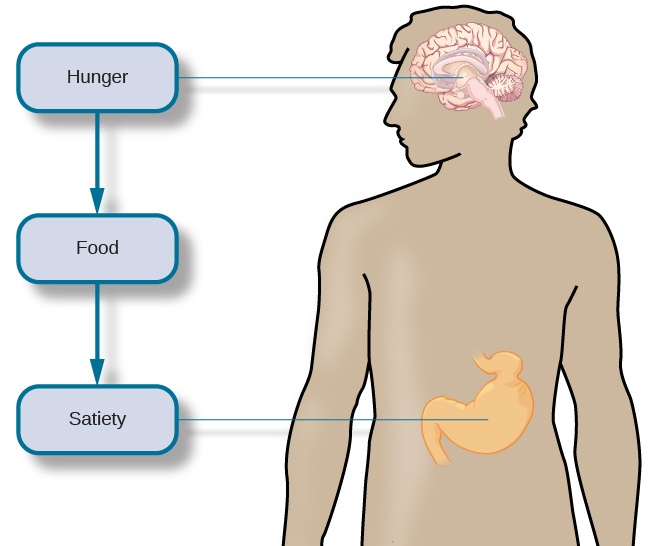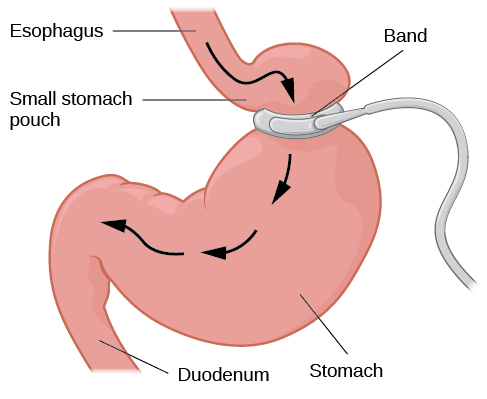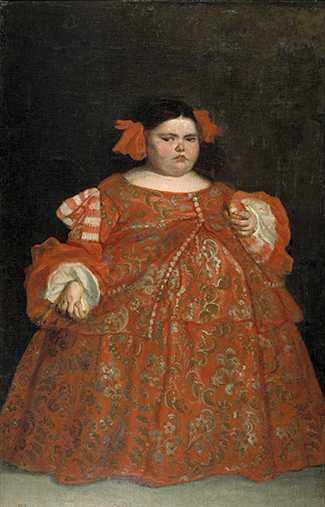11. Hunger, Eating, and Weight
Eating is essential for survival, and it is no surprise that a drive like hunger exists to ensure that we seek out sustenance. While this chapter will focus primarily on the physiological mechanisms that regulate hunger and eating, powerful social, cultural, and economic influences also play important roles. This section will explain the regulation of hunger, eating, and body weight, and we will discuss the adverse consequences of disordered eating.
*
Physiological Mechanisms
There are a number of physiological mechanisms that serve as the basis for hunger. When our stomachs are empty, they contract. Typically, a person then experiences hunger pangs. Chemical messages travel to the brain, and serve as a signal to initiate feeding behavior, or eating. When our blood glucose levels drop, the pancreas and liver generate a number of chemical signals that induce hunger (and thus initiate feeding behavior.
For most people, once they have eaten, they feel satiation, or fullness and satisfaction, and their eating behavior stops. Like the initiation of eating, satiation is also regulated by several physiological mechanisms. As blood glucose levels increase, the pancreas and liver send signals to shut off hunger and eating . The food’s passage through the gastrointestinal tract also provides important satiety signals to the brain (Woods, 2004), and fat cells release leptin, a satiety hormone.
The various hunger and satiety signals that are involved in the regulation of eating are integrated in the brain. Research suggests that several areas of the hypothalamus and hindbrain are especially important sites where this integration occurs. Ultimately, activity in the brain determines whether or not we engage in feeding behavior (Figure 1).

*
Metabolism and Body Weight
Our body weight is affected by a number of factors, including gene-environment interactions, and the number of calories we consume versus the number of calories we burn in daily activity. If our caloric intake exceeds our caloric use, our bodies store excess energy in the form of fat. If we consume fewer calories than we burn off, then stored fat will be converted to energy. Our energy expenditure is obviously affected by our levels of activity, but our body’s metabolic rate also comes into play. A person’s metabolic rate is the amount of energy that is expended in a given period of time, and there is tremendous individual variability in our metabolic rates. People with high rates of metabolism are able to burn off calories more easily than those with lower rates of metabolism.
We all experience fluctuations in our weight from time to time, but generally, most people’s weights fluctuate within a narrow margin, in the absence of extreme changes in diet and/or physical activity. This observation led some to propose a set-point theory of body weight regulation. The set-point theory asserts that each individual has an ideal body weight, or set point, which is resistant to change. This set-point is genetically predetermined and efforts to move our weight significantly from the set-point are resisted by compensatory changes in energy intake and/or expenditure.
Some of the predictions generated from this particular theory have not received empirical support. For example, there are no changes in metabolic rate between individuals who had recently lost significant amounts of weight and a control group (Weinsier et al., 2000). In addition, the set-point theory fails to account for the influence of social and environmental factors in the regulation of body weight . Despite these limitations, set-point theory is still often used as a simple, intuitive explanation of how body weight is regulated.
*
Obesity
When someone weighs more than what is generally accepted as healthy for a given height, they are considered overweight or obese. According to the Centers for Disease Control and Prevention (CDC), an adult with a body mass index (BMI) between 25 and 29.9 is considered overweight (Figure 2). An adult with a BMI of 30 to <35 is considered to have type I obesity, and an adult with a BMI of 35 to <40 is considered to have type II obesity. People who are at risk for death are classified as have type III obesity. Type III obesity is defined as having a BMI over 40. Note that although BMI has been used as a healthy weight indicator by the World Health Organization (WHO), the CDC, and other groups, its value as an assessment tool has been questioned. The BMI is most useful for studying populations, which is the work of these organizations. It is less useful in assessing an individual since height and weight measurements fail to account for important factors like fitness level. An athlete, for example, may have a high BMI because the tool doesn’t distinguish between the body’s percentage of fat and muscle in a person’s weight. Similarly, BMI is not useful for people who are pregnant, disabled, elderly, etc. Public health experts have proposed alternatives to this type of measurement, but so far, it remains in use because it is very easy to calculate.

Being extremely overweight or obese is a risk factor for several negative health consequences. These include, but are not limited to, an increased risk for cardiovascular disease, stroke, Type 2 diabetes, liver disease, sleep apnea, colon cancer, breast cancer, infertility, and arthritis. Given that it is estimated that in the United States around one-third of the adult population is obese and that nearly two-thirds of adults and one in six children qualify as overweight, there is substantial interest in trying to understand how to combat this important public health concern. The emphasis placed on weight and weight loss can also have profound psychological effects on individuals and contribute to increased stress and anxiety, which are themselves important public health concerns.
What causes someone to be overweight or obese? You have already read that both genes and environment are important factors for determining body weight, and if more calories are consumed than expended, excess energy is stored as fat. However, socioeconomic status and the physical environment must also be considered as contributing factors. For example, an individual who lives in an impoverished neighborhood that is overrun with crime may never feel comfortable walking or biking to work or to the local market. This might limit the amount of physical activity in which he engages and result in an increased body weight. Similarly, some people may not be able to afford healthy food options from their market, or these options may be unavailable (especially in urban areas or poorer neighborhoods); therefore, some people rely primarily on available, inexpensive, high fat, and high calorie fast food as their primary source of nutrition.
Generally, overweight and obese individuals are encouraged to try to reduce their weights through a combination of both diet and exercise. While some people are very successful with these approaches, many struggle to lose excess weight. In cases in which a person has had no success with repeated attempts to reduce weight or is at risk for death because of obesity, bariatric surgery may be recommended. Bariatric surgery is a type of surgery specifically aimed at weight reduction, and it involves modifying the gastrointestinal system to reduce the amount of food that can be eaten and/or limiting how much of the digested food can be absorbed (Figure 3).

In recent years, so-called “weight loss drugs” have also become common in treating obesity. The most popular drugs currently in use are GLP-receptor agonists. These drugs mimic a naturally occurring hormone that regulates blood sugar levels and were initially developed to treat diabetes. In addition to impacting how our bodies control sugar levels, these drugs appear to directly affect the brain. Specifically, weight loss drugs such as Wegovy (prescribed specifically for weight loss) and Ozempic (used off-label for weight loss) seem to help people resist the urge to overeat, but also make it easier for people to quit smoking, recover from gambling addiction, etc.
Link to Learning
Prader-Willi Syndrome (PWS) is a genetic disorder that results in persistent feelings of intense hunger and reduced rates of metabolism. Typically, affected children have to be supervised around the clock to ensure that they do not engage in excessive eating. Currently, PWS is the leading genetic cause of type III obesity in children, and it is associated with a number of cognitive deficits and emotional problems (Figure 4).

While genetic testing can be used to make a diagnosis, there are a number of behavioral diagnostic criteria associated with PWS. From birth to 2 years of age, lack of muscle tone and poor sucking behavior may serve as early signs of PWS. Developmental delays are seen between the ages of 6 and 12, and excessive eating and cognitive deficits associated with PWS usually onset a little later.
While the exact mechanisms of PWS are not fully understood, there is evidence that affected individuals have hypothalamic abnormalities. This is not surprising, given the hypothalamus’s role in regulating hunger and eating. However, as you will learn in the next section of this chapter, the hypothalamus is also involved in the regulation of sexual behavior. Consequently, many individuals suffering from PWS fail to reach sexual maturity during adolescence.
There is no current treatment or cure for PWS. However, if weight can be controlled in these individuals, then their life expectancies are significantly increased (historically, sufferers of PWS often died in adolescence or early adulthood). Advances in the use of various psychoactive medications and growth hormones continue to enhance the quality of life for individuals with PWS (Cassidy & Driscoll, 2009; Prader-Willi Syndrome Association, 2012).
*
Eating Disorders
While nearly two out of three US adults struggle with issues related to being overweight, a smaller, but significant, portion of the population has eating disorders that typically result in being normal weight or underweight. Often, these individuals are fearful of gaining weight. Individuals who suffer from bulimia nervosa and anorexia nervosa face many adverse health consequences.
People suffering from bulimia nervosa engage in binge eating behavior (eating a very large amount of food in a short time) that is followed by an attempt to compensate for the large amount of food consumed. Purging the food by inducing vomiting or through the use of laxatives are two common compensatory behaviors. Some affected individuals engage in excessive amounts of exercise to compensate for their binges. Bulimia is associated with many adverse health consequences that can include kidney failure, heart failure, and tooth decay. In addition, these individuals often suffer from anxiety and depression, and they are at an increased risk for substance abuse. The lifetime prevalence rate for bulimia nervosa is estimated at around 1% for women and less than 0.5% for men.
Binge eating disorder is similar to bulimia nervosa in that people suffering from it engage in binge eating behavior. Unlike with bulimia, eating binges are not followed by inappropriate behavior, such as purging, but they are followed by distress, including feelings of guilt and embarrassment. The resulting psychological distress distinguishes binge eating disorder from overeating.
Anorexia nervosa is an eating disorder characterized by the maintenance of a body weight well below average through starvation and/or excessive exercise. Individuals suffering from anorexia nervosa often have a distorted body image, referenced in literature as a type of body dysmorphia, meaning that they view themselves as overweight even though they are not. Like bulimia nervosa, anorexia nervosa is associated with a number of significant negative health outcomes: bone loss, heart failure, kidney failure, amenorrhea (cessation of the menstrual period), reduced function of the gonads, and in extreme cases, death. Furthermore, there is an increased risk for a number of psychological problems, which include anxiety disorders, mood disorders, and substance abuse. Estimates of the prevalence of anorexia nervosa vary from study to study but generally range from just under one percent to just over four percent in women. Generally, prevalence rates are considerably lower for men.
Link to Learning
While both anorexia and bulimia nervosa occur in men and women of many different cultures, Caucasian females from Western societies tend to be the most at-risk population. Recent research indicates that females between the ages of 15 and 19 are most at risk, and it has long been suspected that these eating disorders are culturally-bound phenomena that are related to messages of a thin ideal often portrayed in popular media and the fashion world (Figure 5). While social factors play an important role in the development of eating disorders, there is also evidence that genetic factors may predispose people to these disorders.

*
Section Summary
Hunger and satiety are highly regulated processes that result in a person maintaining a fairly stable weight that is resistant to change. When more calories are consumed than expended, a person will store excess energy as fat. Being significantly overweight adds substantially to a person’s health risks and problems, including cardiovascular disease, type 2 diabetes, certain cancers, and other medical issues. Sociocultural factors that emphasize thinness as a beauty ideal and a genetic predisposition contribute to the development of eating disorders in many young females, though eating disorders span ages and genders.
*
Glossary
- anorexia nervosa
- eating disorder characterized by an individual maintaining body weight that is well below average through starvation and/or excessive exercise
- bariatric surgery
- type of surgery that modifies the gastrointestinal system to reduce the amount of food that can be eaten and/or limiting how much of the digested food can be absorbed
- binge eating disorder
- type of eating disorder characterized by binge eating and associated distress
- bulimia nervosa
- type of eating disorder characterized by binge eating followed by purging
- distorted body image
- individuals view themselves as overweight even though they are not
- leptin
- satiety hormone
- metabolic rate
- amount of energy that is expended in a given period of time
- overweight
- adult with a BMI between 25 and 29.9
- satiation
- fullness; satisfaction
- set point theory
- assertion that each individual has an ideal body weight, or set point, that is resistant to change
-
- type I obesity
- adult with a BMI of 30 to <35
-
- type II obesity
- adult with a BMI of 35 to <40
-
- type III obesity
- adult with a BMI over 40
-
CC LICENSED CONTENT, SHARED PREVIOUSLY
OpenStax, Psychology, Section 10.2 Hunger and Eating
Provided by: Rice University
Access for free at https://openstax.org/details/books/psychology-2e
License: CC-BY 4.0
Adapted By: Kristina Prescott

